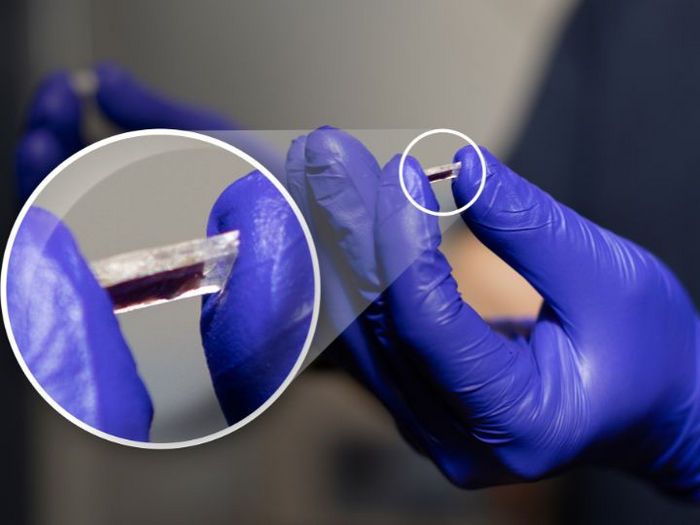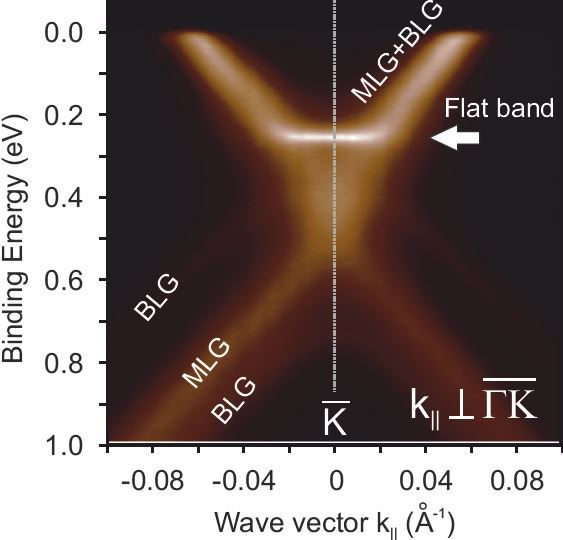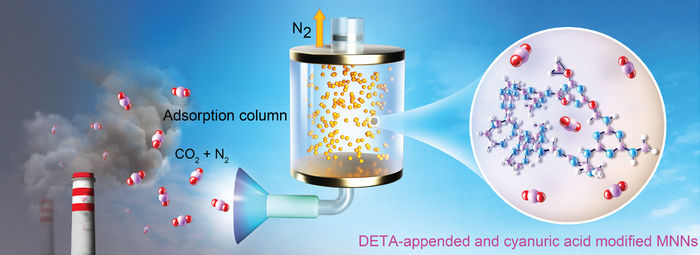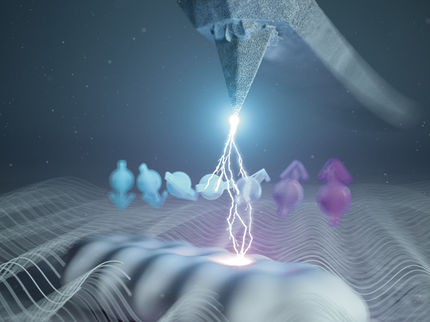Direct observation of the ad- and desorption of guest atoms into a mesoporous host
New insights into energy materials
Battery electrodes, storage devices for gases, and some catalyst materials have tiny functional pores that can accommodate atoms, ions, and molecules. How these guest atoms are absorbed into or released from the pores is crucial to understanding the porous materials' functionality. However, usually these processes can only be observed indirectly. A team from the Helmholtz Zentrum Berlin (HZB) has employed two experimental approaches using the ASAXS instrument at the PTB X-ray beamline of the HZB BESSY II synchrotron to directly observe the adsorption process of atoms in a mesoporous model system. The work lays the foundations for new insights into these kinds of energy materials.

From the measurement data, the team was able to determine that the xenon atoms first accumulate on the inner walls of the pores (state 1), before they fill them up (state 2). The X-ray beam penetrates the sample from below.
© M. Künsting/HZB
Most battery materials, novel catalysts, and storage materials for hydrogen have one thing in common: they have a structure comprised of tiny pores in the nanometer range. These pores provide space which can be occupied by guest atoms, ions, and molecules. As a consequence, the properties of the guest and the host can change dramatically. Understanding the processes inside the pores is crucial to develop innovative energy technologies.
Observing the filling process
So far, it has only been possible to characterise the pore structure of the substrate materials precisely. The exact structure of the adsorbate inside the pores has remained hidden. To probe this, a team from the HZB together with colleagues from the University of Hamburg, from Germany’s national metrology institute PTB, and Humboldt-Universität zu Berlin combined for the first time two different X-ray methods applied in-situ during filling and emptying of the porous host. Doing so, they made the structure of the guest atoms alone visible.
Model system: Mesoporous Silicon with Xenon
The team examined the process on a model system made of mesoporous silicon. The noble gas xenon was brought into contact with the silicon sample in a custom-made physisorption cell under temperature and pressure control. They examined the sample using anomalous small-angle X-ray scattering (ASAXS) and X-ray absorption near-edge structure (XANES) spectroscopy simultaneously, near the X-ray absorption edge of the guest xenon. In this way, they were able to sequentially record how xenon migrates into the pores. They could observe that the atoms first form a monoatomic layer on the pores' inner surfaces. Further layers are added and undergo rearrangements until the pores are filled. It gets clear that the filling and emptying of the pores proceed through different mechanisms with distinct structures.
Signal of the Xenon guests extracted
“Using conventional X-ray scattering (SAXS), you mainly see the porous material, the contributions of the guests are hardly visible”, says Eike Gericke, first author of the study, who is doing his PhD on X-ray techniques. “We changed that by using ASAXS and measured at the X-ray absorption edge of xenon. The interactions between xenon and the X-ray beam change at this edge, so we can mathematically extract the signal of the xenon guests.”
Empirical insight into confined matter
“This gives us for the first time direct access to an area that previously could only be speculated about“, explains Dr. Armin Hoell, a corresponding author of the paper. "Applying the combination of these two X-ray methods to the process now makes it possible to observe the behaviour of matter confined in nanostructures empirically. This is a powerful new tool to gain deeper insights into battery electrodes, catalysts, and hydrogen storage materials.”
Original publication
Eike Gericke, Dirk Wallacher, Robert Wendt, Giorgia Greco, Michael Krumrey, Simone Raoux, Armin Hoell, and Simone Mascotto; "Direct Observation of the Xenon Physisorption Process in Mesopores by Combining In Situ Anomalous Small-Angle X-ray Scattering and X-ray Absorption Spectroscopy"; Journal of Physical Chemistry Letters (Open Access, 2021)
Most read news
Original publication
Eike Gericke, Dirk Wallacher, Robert Wendt, Giorgia Greco, Michael Krumrey, Simone Raoux, Armin Hoell, and Simone Mascotto; "Direct Observation of the Xenon Physisorption Process in Mesopores by Combining In Situ Anomalous Small-Angle X-ray Scattering and X-ray Absorption Spectroscopy"; Journal of Physical Chemistry Letters (Open Access, 2021)
Topics
Organizations
Other news from the department science

Get the chemical industry in your inbox
By submitting this form you agree that LUMITOS AG will send you the newsletter(s) selected above by email. Your data will not be passed on to third parties. Your data will be stored and processed in accordance with our data protection regulations. LUMITOS may contact you by email for the purpose of advertising or market and opinion surveys. You can revoke your consent at any time without giving reasons to LUMITOS AG, Ernst-Augustin-Str. 2, 12489 Berlin, Germany or by e-mail at revoke@lumitos.com with effect for the future. In addition, each email contains a link to unsubscribe from the corresponding newsletter.
Most read news
More news from our other portals
See the theme worlds for related content
Topic World Spectroscopy
Investigation with spectroscopy gives us unique insights into the composition and structure of materials. From UV-Vis spectroscopy to infrared and Raman spectroscopy to fluorescence and atomic absorption spectroscopy, spectroscopy offers us a wide range of analytical techniques to precisely characterize substances. Immerse yourself in the fascinating world of spectroscopy!

Topic World Spectroscopy
Investigation with spectroscopy gives us unique insights into the composition and structure of materials. From UV-Vis spectroscopy to infrared and Raman spectroscopy to fluorescence and atomic absorption spectroscopy, spectroscopy offers us a wide range of analytical techniques to precisely characterize substances. Immerse yourself in the fascinating world of spectroscopy!
Topic World Battery Technology
The topic world Battery Technology combines relevant knowledge in a unique way. Here you will find everything about suppliers and their products, webinars, white papers, catalogs and brochures.

Topic World Battery Technology
The topic world Battery Technology combines relevant knowledge in a unique way. Here you will find everything about suppliers and their products, webinars, white papers, catalogs and brochures.
Last viewed contents
HLA-DR
Secondary_electrons
Perfluorooctanoic_acid

Researchers develop sensors that operate at high temperatures and in extreme environments - Sensitive, reliable and durable sensors created for multiple industries
Category:Enzymes_by_cofactor

Graphene on the way to superconductivity

A simple, cheap material for carbon capture, perhaps from tailpipes - Porous material from melamine efficiently captures CO₂ from flue gases





























































